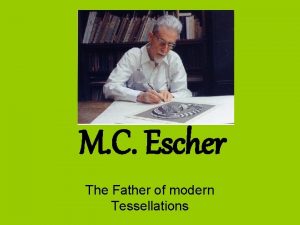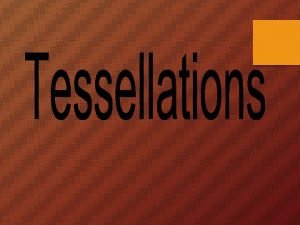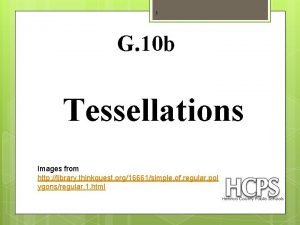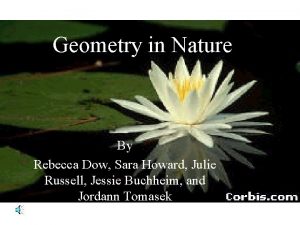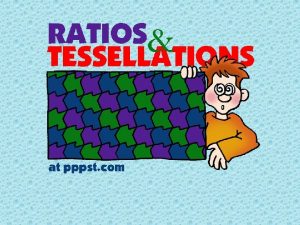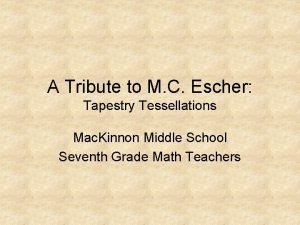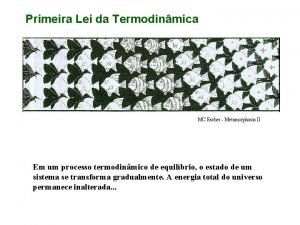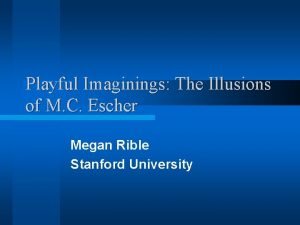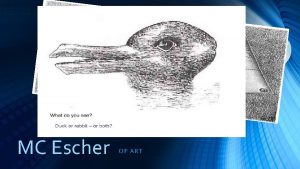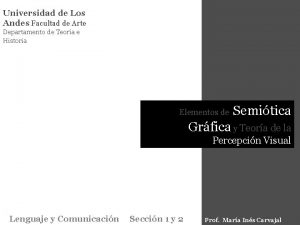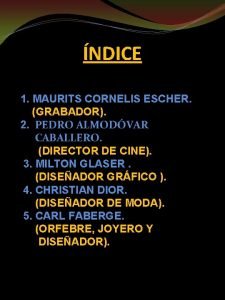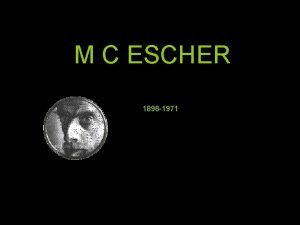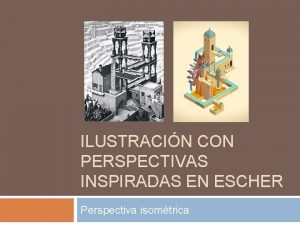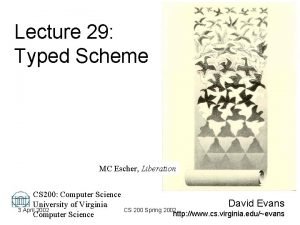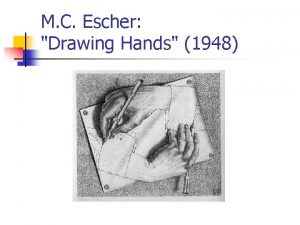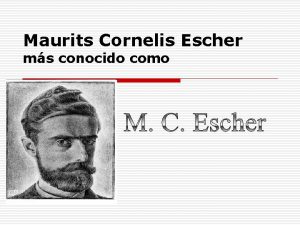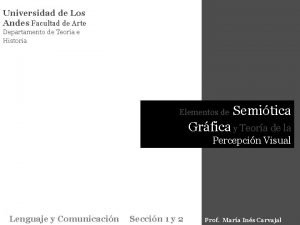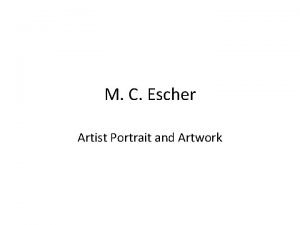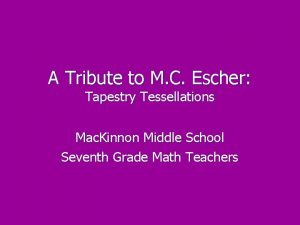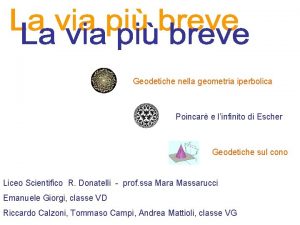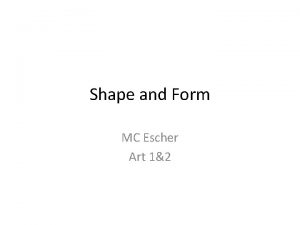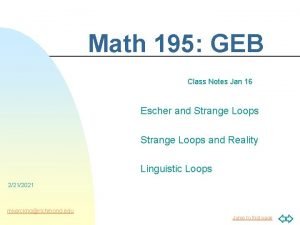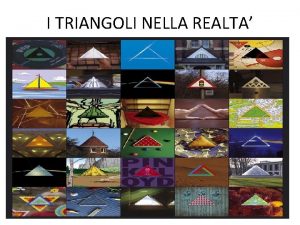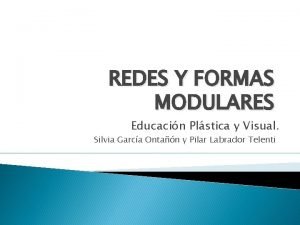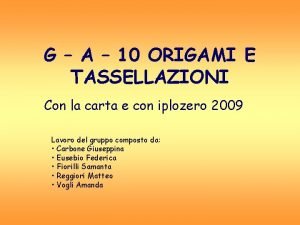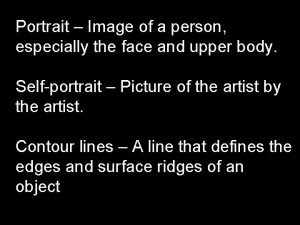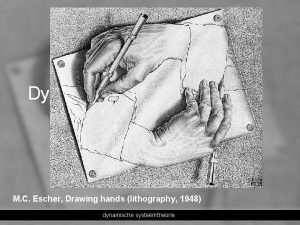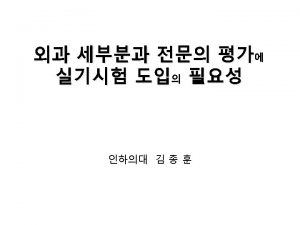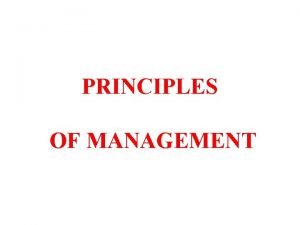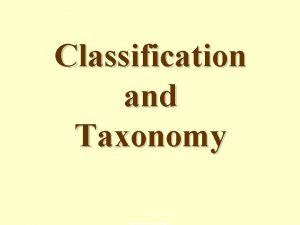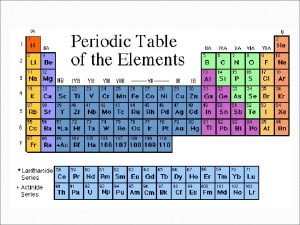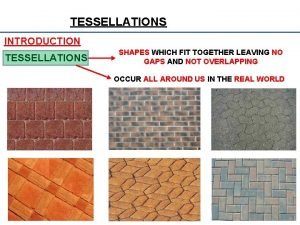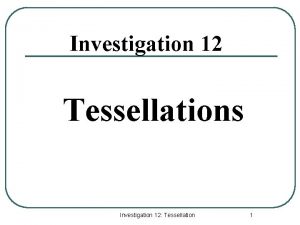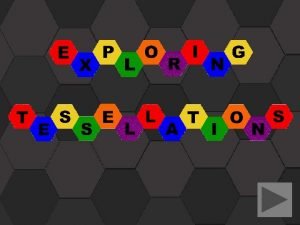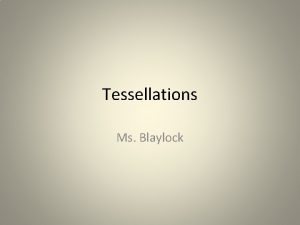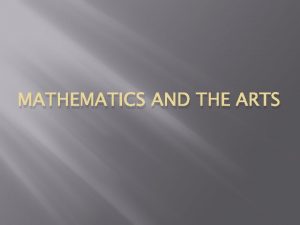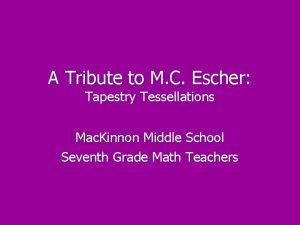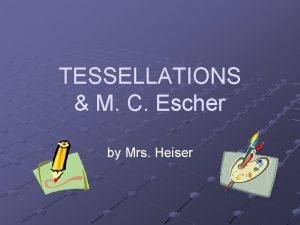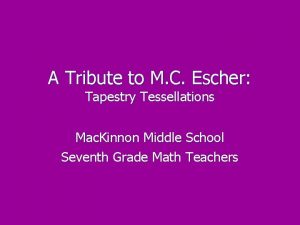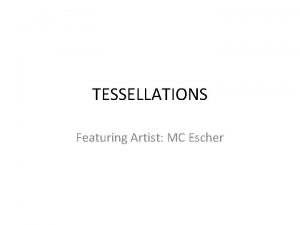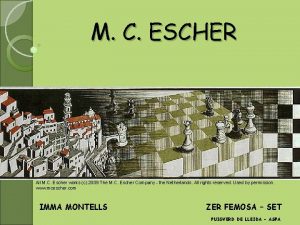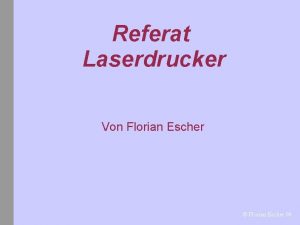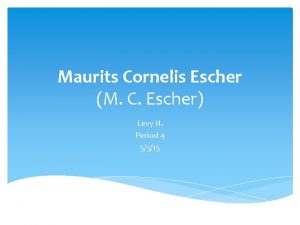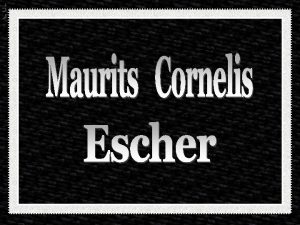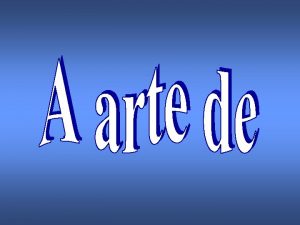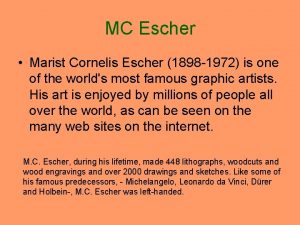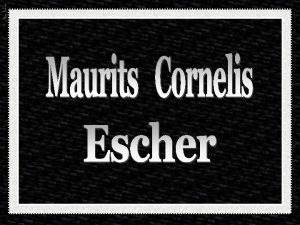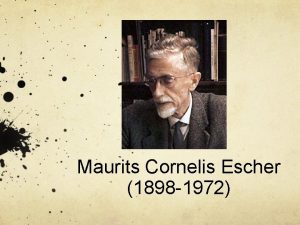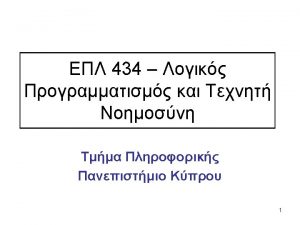M C Escher The Father of modern Tessellations





































- Slides: 37

M. C. Escher The Father of modern Tessellations

Who is M. C. Escher? • Escher was born in Leeuwarden in Holland on June 17 th, 1898. • He was the youngest of 4 brothers. • He is usually referred to by his initials which stand for Maurits, Cornelis. • His family called him Mauk. • This is one of his self portraits.

How did he get started in Art? • Here his art teacher noticed he had a liking for pen and ink drawings and taught him how to make linocuts. • He became good at it and sent some to the best known graphic artist at the time, Roland Holtz, who was impressed and suggested he switch to wood. • Escher began failing in school, so Holtz suggested that he become and architect to motivate him to work harder. Head of child, 1916

A teacher made the difference Self Portrait in Chair, 1920 • In 1918, Escher enrolled in the School for Architecture and Decorative Arts' in Haarlem, Holland where he studied until 1922. • Escher showed one of his favorite teachers, Mesquita, one of his prints and he loved it. • Mesquita saw Escher’s potential and got permission for Escher to change courses and put him on the road to becoming a famous printmaker.

You may recognize some of his work




He created the pen and ink drawing “ 8 Heads” in 1922. Although it is not a tessellation, it is an indicator of what was about to come. Escher loved to play with you mind. For example, when you flip the drawing…

The heads can be seen from different views.




The block print “Lions” was his first attempt at creating a tessellation. • He printed his tessellation in gold and silver ink on silk… • And was rather disappointed that people weren’t more impressed with it.

What gave him the idea to make a tessellation in the first place? • The tilings in the Alhambra in Spain were laid out by the Moors in the 14 th century. • They are made of colored tiles forming patterns, many truly symmetrical. • By our definition, they are not tessellations but they did inspire the young M. C Escher, who copied them into his notebooks and later converted some into true tessellations. • Escher noted that the tilings never included animals or plants. His tessellations hardly ever left them out! Escher's drawing of Alhambra tiling.

What are Tessellations The word 'tessera' in latin means a small stone cube. They were used to make up 'tessellata' - the mosaic pictures forming floors and tilings in Roman buildings.

Today, the term has become more specialized and is used to refer to pictures or tiles, mostly in the form of animals and other life forms, which cover the surface of a plane in a symmetrical way without overlapping or leaving gaps. A tessellation is created when a shape is repeated over and over again covering a plane without any gaps or overlaps. Another word for a tessellation is a tiling.

Escher quickly became obsessed with the process and discovered mathematical equations and properties to help create his tessellations.

Escher discovered that ALL parallelograms will tessellate.

Escher used four main mathematical functions Translation Glide-reflection Rotation Reflection

China Boy 1936 Squirrels 1936

Next, he started creating tessellations within tessellations.

His obsession led him to begin playing with his tessellations to see how far he could stretch the mind.




Playing with the mathematical equations, he started to stretch his understanding of what a tessellation could do.



During his life, he became obsessed with filling the plane with pictures that did not overlap or leave spaces. Aged 68, he stated, "Filling the plane has become a real mania to which I have become addicted and from which I sometimes find it hard to tear myself away. "

Escher has inspired artists to create tessellations of their own. Look at some of the tessellations that students have done. Motorbikes by Pete Akroyde

Princes on Parade by Pat Lore

Gone Fishin' by Heather Herrick

Angel Fish ? by Gary Casper

Turtles by Bjørn Gustum

Creepy Crawlie by Sara Kelly (6 th grade).

Now, try it on your own! • Cut out your tessellation from the four inch square. • Tape it together so it won’t fall apart. • Trace it in your sketchbook three times to make sure that it will tessellate (rotate). • Create three possible sketches that will fill the shape completely. • Remember that there shouldn’t be any negative or empty spaces.
 Father of tesselation
Father of tesselation Semi regular tessellation examples
Semi regular tessellation examples Escher ghosts
Escher ghosts Examples of tessellations in nature
Examples of tessellations in nature Types of tessellations
Types of tessellations Tapestry
Tapestry Escher ghosts
Escher ghosts Trabalho realizado pelo sistema
Trabalho realizado pelo sistema Mc escher illusions
Mc escher illusions Escher op art
Escher op art Escher barcelona
Escher barcelona Maurits cornelis escher biografia
Maurits cornelis escher biografia M.c. escher castrovalva (1930)
M.c. escher castrovalva (1930) Day and night escher
Day and night escher Mc escher liberation
Mc escher liberation Drawing hands escher
Drawing hands escher M.c. escher biografia
M.c. escher biografia Escher barcelona
Escher barcelona M c escher portrait
M c escher portrait M. c. escher tapestry
M. c. escher tapestry Escher geometria iperbolica
Escher geometria iperbolica Brian fath
Brian fath What is an open shape
What is an open shape Escher
Escher Triangolo escher
Triangolo escher Red modular cuadrada
Red modular cuadrada Tassellazione escher
Tassellazione escher Mc escher self portrait
Mc escher self portrait Dynamische systeemtheorie
Dynamische systeemtheorie The father of modern medicine
The father of modern medicine Paperclips space exploration
Paperclips space exploration Father of administrative management
Father of administrative management What is the genus of a species
What is the genus of a species Father of marketing
Father of marketing Father of modern pharmacy
Father of modern pharmacy History of physical education in denmark
History of physical education in denmark Father of modern periodic table of elements
Father of modern periodic table of elements Who is the father of modern economics
Who is the father of modern economics
